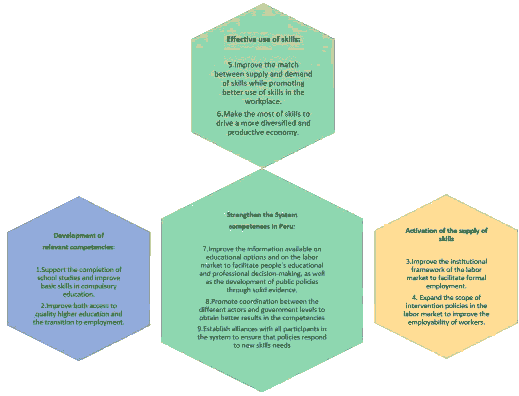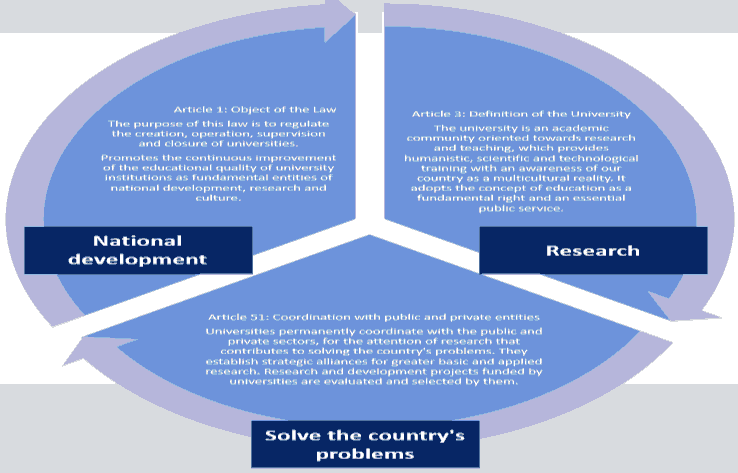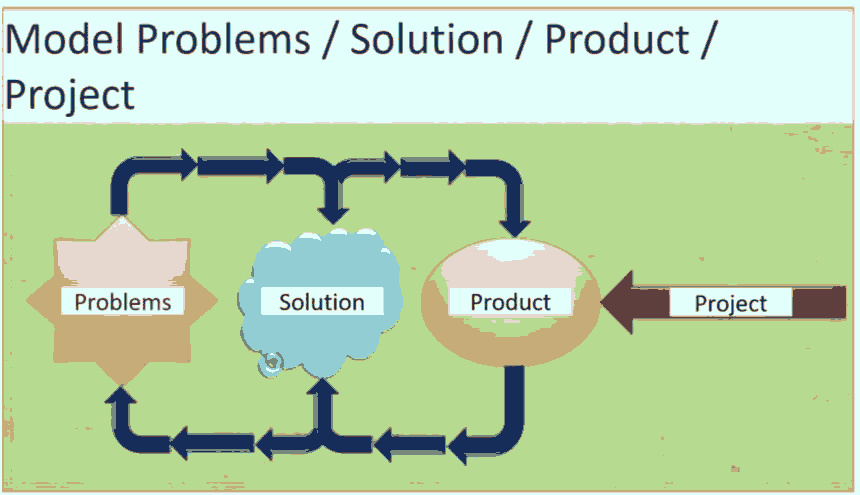Research Article: 2021 Vol: 24 Issue: 6S
University Licensing and the Problems of Peruvian Society
Ricardo Fernando Cosio Borda,Universidad Autónoma del Perú
Liz Maribel Robladillo Bravo,Universidad César Vallejo
Isabel Menacho Vargas, Universidad César Vallejo, Lima
Monica Elisa Meneses-La-Riva,Universidad César Vallejo
Raúl Alberto Rengifo Lozano,Universidad Nacional Mayor de San Marcos
Francis Esmeralda Ibarguen Cueva,Universidad César Vallejo
Abstract
For many people there is not much clarity about the level of relationship between the Academy and the problems of the Society. Perhaps the first question to be asked is: is there a need for such a relationship, or is it not necessary? Then doubts arise as to how it can be proven that there should be this interrelation; meanwhile, it could be qualified as a risk or uncertainty, which can positively or negatively affect the country. The model is supported by the results of indicators from OECD and World Economic Forum reports. This paper develops the first reasons that justify this approach and presents the Problem/Solution/Product/Project model and the first findings of two applications and some lessons learned.
Keywords
Educational Model, Competencies, Problem Solution, Product
Introduction
The labor of the Academy is a work of high impact when it is quantified in its real magnitude. The contact with young students during the exercise of the teaching work allows to perform a task that is not properly valued by many, but represents a high impact in the changes required by the society. This condition may generate a risk because the impact of education on society may be either positive or negative depending on whether the topics in the development of any course or subject obey a real need for academic training at the highest level, and that is oriented to work for the competitiveness of the country. All this effort requires the development of adequate and necessary competencies in relation to clear vision about the model or professional profile to be achieved, and the requirements of the country for reaching present and future goals.
These considerations merit thinking about the degree of rapprochement that the Academy has with the current problems of society; for this reason, this study proposes an educational model aimed at achieving a rapprochement between students in training with the problems of society.
The Problem/Solution/Product/Project model, which for ease of reference will be called PSPP, is based on the information provided by the students themselves, who point out the problems that affect society's environment and which therefore require work in terms of solution proposals by the Academy.
This proposal is framed in Article 51 of the new University Law that states: "In conjunction with public and private entities, universities must permanently coordinate the attention of research that contributes to solve the problems of the country." According to what is stated in this article, a total reciprocal approach of the Academy with the problems of society is required, and clearly the leadership role would correspond to the Academy.
The OECD (2016) report states in the "OECD Skills Strategy, Diagnostic Report: Peru" that the need and criticality of improving skills to enhance the country's competitiveness is analyzed, and to the simple question: Where are key skills generated? The answer is in the academy.
According to this report (OECD, 2016), "In the 21st century, skills have become a key factor in achieving individual well-being and economic success for any country. Without adequate investment in skills, people are left on the margins of society, (...)"
Finally, in the present study, the objectives oriented to achieve the relationship of the Academy with the Society will be presented and the solution of the country's problems will be proposed.
Methodology
Need to Improve the Global Competitiveness Index
According to the report cited above from (OECD, 2016), in terms of competencies, “(...) countries strive harder to achieve higher levels of innovation and competitiveness in their economies, and will have to focus more on generating the right mix of skills, ensuring that these skills are fully activated in the labor market (...).”
From the same report (OECD, 2016), OECD countries have developed a number of instruments to foster knowledge dissemination and collaboration between academia and business. While knowledge and research generated by the public research system is disseminated through a variety of channels, such as academic staff mobility, scientific publications, congresses, contract research with industry and licensing of academic inventions, a great deal of policy attention in OECD countries has focused on promoting knowledge transfers, through publications, patents and licensing of academic inventions and the promotion of university projects.
The OECD report that the "Skills Strategy Diagnostic Report: Peru" touches on a key issue that is reflected in the global competitiveness index and that, according to data from the 2019 and 2018, reports have been elaborated, as shown in Table 1.
It is clearly observed that there is a drop in the global competitiveness index, and for the purposes of this report, the data of the two key pillars are detailed in Table 1. It is important to point out that these pillars are directly related to the competencies of the graduates of all universities and the direct relationship of the Academy with the problems of Society. For this reason, it is necessary to improve the actions carried out in Peru in relation to the components of each of the two pillars detailed in Table 1
| Table 1 Components Of Each Of The Two Pillars: Skills And Innovation Capacity |
||
|---|---|---|
| 2019 | 2018 | |
| Global Competitiveness Index | ||
| 6th pillar: Skills | ||
| Current staff | ||
| 6.01 Average years of schooling | ||
| Skills of the current workforce | ||
| 6.02 Scope of Personnel Training | ||
| 6.03 Quality of vocational training | ||
| 6.04 Graduate skills | 110 | |
| 6.05 Digital skills among the labor force | ||
| 6.06 Ease of finding qualified employees | 114 | |
| Future workforce | ||
| 6.07 School life expectancy in years | ||
| Skills of the future workforce | ||
| 6.08 Critical Thinking in Teaching | ||
| 6.09 Pupil/teacher ratios in primary education ratio | ||
| 12th pillar: Innovation capacity | ||
| Interaction and diversity | ||
| 12.01 Workforce diversity | ||
| 12.02 Status of cluster development | 102 | 101 |
| 12.03 International co-inventions per million population. | 101 | |
| 12.04 Multi-stakeholder collaboration | ||
| Research and development | ||
| 12.05 Scientific publications score | ||
| 12.06 patent applications per million inhabitants | 86 | |
| 12.07 R&D expenditure as a % of GDP | ||
| 12.08 prominence of research institutions | ||
| Marketing | ||
| 12.09 Buyer sophistication | ||
| 12.10 Trademark applications per million inhabitants. | ||
Competencies as Results of the Academy-Society Relationship
According to (OECD, 2016), It is the time to leverage Peru's human capital skills to drive innovation and inclusive growth for the future, while effectively tackling informality.
On the other hand, in the same report (OECD, 2016), skills do more than increase employment, income and aggregate growth. The information collected in the PIAAC shows that, in all countries, adults with high basic skills, such as literacy and numeracy, are healthier, perceive themselves as participants in political processes, and trust others more than those with lower skills. In short, the achievement of higher skill levels fosters equity and facilitates people's participation in democracy and society. Figure 1 shows the nine challenges in terms of competencies in Peru, and according to this model, there are four (04) grouping categories of competencies.
As shown in Figure 1, it is necessary for Peru to develop models, actions and strategies to improve competencies. This supports the proposal of the present study of bringing the academy closer to the problems of society.
New University Law 30220 and the Need for Academia-Society Relationship
The new University Law 30220 was enacted on July 03, 2014 to date it has more than six (06) years of implementation. For the purposes of this research, special emphasis will be given to the analysis, discussion and implementation of three articles of the Law that are considered key:
• Article 1. Object of the Law.
• Article 3. Definition of the University.
• Coordination with public and private entities.
Figure 2 represents the support for the following sentence: "Universities must develop research to solve the country's problems and thus lead national development".
As part of the analysis carried out, Law 30220 is considered to be a disruptive event. The word disruptive is used as an adjective to qualify an abrupt rupture. On the other hand, the term disruptive refers to something that causes a decisive change.
Problem/Product/Solution/Project Model
The Problem/Solution/Product/Project model (see Figure 3) has been implemented in the Mechanical Engineering Faculty of the Universidad Nacional de Ingeniería since 2018, in the MS 413 project management course.
This innovative model requires a change in the methodology of engineering education, since it brings together a series of criteria, skills and expected competencies, in the face of criticism of academic training:
a) A number of studies have pointed out the lack of problem-solving skills of university graduates.
b) Similarly, the lack of capacity to apply the knowledge acquired is criticized, and it is often pointed out that pre-professional internships are needed.
c) There is no facility to identify problems and be able to propose solutions that represent the satisfaction of society's needs and problems.
d) In view of the problems foreseen by the new Law 30220 in its key articles detailed in Figure 2, this model becomes an interesting option in accordance with Article 51 of Law 30220:
e) The model seeks to take society's problems directly as its own.
f) To implement the model, it is necessary to apply the basics of applied research methodology.
g) The model considers a series of tools, options and measures that respond to scientific research in its connotation of applied research.
h) Through the application of the proposal, students attain new capabilities that allow them to have human capital oriented to the solution of problems.
As shows in Figure 3.
Figure 3: Educational Model Applied in the MS 413 Project Management Course
Source: Own Elaboration.
Problem/Product/Solution/Project Model Applications
Application of the model at UPAO course for Civil Engineering professors
On August 21, 22, 28 and 29/2020, the course Project Management: Basis of Civil Engineering Education was for professors of Civil Engineering at UPAO (Universidad Privada Antenor Orrego). The content of the course was as shown in Table 2, which shows that an important part of the course was to develop and apply the Problem/Solution/Product/Project model. In this case it is more important, since the twenty-two (22) participants were teachers, and therefore have a multiplying effect on their students.
| Table 2 Contents Of The Course Project Management: Basis Of Civil Engineering Education |
|||
|---|---|---|---|
| Day | Date | Schedule | Content |
| Day 1 | 21/08/2020 | 18.00 to 22.00 | -Premises -Engineering definition and mission. Case and project discussion - Problem/Solution/Product/Project Model |
| Day 2 | 22/08/2020 | 08.00 to 14.00 | Role of engineering in public policies. PNCP case. Discussion of cases and projects |
| Day 3 | 28/08/2020 | 18.00 to 22.00 | Project management philosophy. Discussion of scope, time, cost, cost, quality, uncertainty model and project management baselines. |
| Day 4 | 29/08/2020 | 08.00 to 14.00 | - Project management philosophy. Development of scope, time, cost, quality, uncertainty model and project management baselines. - Application of the integral model - Conclusions and recommendations |
A survey was applied to all teachers in order to validate the model and the results are shown in Tables 3, 4 and Figure 5: a) Table 3: Details of the questions of the survey conducted via the Survey Monkey application, b) Figure 5: details the responses of teachers surveyed and 18 teachers responded, and c) Table 04: Question 7 had an option for an open answer and 14 teachers gave their opinion and it is detailed in this table. All 14 teachers gave their opinion on the need for the application of the model presented.
| Table 3 Peruvian Universities Ranked In The Top 200 In Latin America |
|||||
|---|---|---|---|---|---|
| No | Questions | Yes | No | No | Score |
| 1 | Do you agree that research is the key or part of the academic mission? | 18 | 0 | 0 | 0 |
| 2 | For the academy to fulfill its mission, it must necessarily articulate with its environment.? | 18 | 0 | 0 | 0 |
| 3 | Do you consider that in order to fully comply with Article 51 of Law 30220 it will be necessary to strengthen the research methodology? | 18 | 0 | 0 | 0 |
| 4 | Do you agree that for the country to take off in the development of its academia, it must fulfill its role of preparing the appropriate human capital? | 18 | 0 | 0 | 0 |
| 5 | Do you consider that applied research requires the development of programmed courses? | 17 | 1 | 0 | 0 |
| 6 | Do you consider that the teacher-student relationship is the key for each course to provide solutions to the problems of the environment? | 16 | 1 | 1 | 0 |
| 7 | What is your opinion on the proposed Problem/Solution/Product/Project model as a means for Applied research? | 4 | 0 | 0 | 14 |
| 8 | Do you believe that academia should lead the construction of the country's future, setting the lines of development and training the appropriate human capital? | 15 | 1 | 2 | 0 |
| * | Express your opinion (be explicit) | ||||


